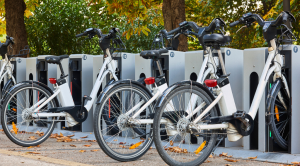
Advocates, government staff, and bicycle enthusiasts from across the state gathered to discuss the growing world of e-bikes, the benefits of electrified mobility, and the remaining challenges to wider adoption. The summit featured presentations and discussions focused on education, policy best practices, strategies for broader adoption, and ongoing industry challenges.
This post provides an overview of the biggest takeaways from the summit and insights into how GPI is working to make the benefits of electric micromobility available to all.
Keynote address from author of When Driving is Not an Option
Anna Zivarts delivered the keynote presentation. Anna leads the Disability Mobility Initiative at Disability Rights Washington. She also authored When Driving Is Not An Option. This book uses the experiences of involuntary nondrivers, as well as Anna’s own life as a visually impaired nondriver, to showcase how improving our transportation systems for those who cannot drive will create a system that functions better for everyone. Anna spoke about the millions of nondrivers in the United States today and the challenges they face traversing their communities, especially those who live in places without reliable public transportation.
Importantly, Anna highlighted the large number of nondrivers, including herself, who are still able to bike and the difference that e-bikes—especially e-cargo bikes—make in their lives, allowing them to move freely without the inconvenience and anxiety that comes with constantly asking friends and family for rides.
Infrastructure matters
One of the most important takeaways from the summit was the need for better bicycle infrastructure throughout Minnesota. Even in the Twin Cities, where relatively good bike infrastructure exists, biking on the roads can be dangerous and frightening for many.
Well-designed infrastructure is critical to expanding the adoption of e-bikes and providing peace of mind for inexperienced bikers, visually impaired riders, or bikers riding with children.
The e-bike business is booming
The popularity of e-bikes was an underlying theme throughout the summit. According to the market research group Circana, e-bikes accounted for 63 percent of the growth in sales of all bicycles between 2019 and 2023.
A perfect example of this growing interest was the 2024 e-bike rebate program in Minnesota. The state legislature allocated $2 million to provide up to $1,500 in rebates for an individual to put toward an e-bike, taking notes from similar programs in states like Colorado. There was enormous interest, leading to the application portal closing after 18 minutes and a waiting room reaching more than 61,000 hopeful applicants. The program expects to receive similar interest in 2025.
E-bikes are fun!
One of the themes for this year’s summit was joy. Anna Zivarts discussed how simply allowing neighbors to test out her e-bike was enough for them to understand the practical benefits of electric micromobility and how fun it is.
E-bikes allow so many new people to experience the joy and freedom bikes offer, and that fact shouldn’t be undervalued.
Work to do to expand access to the benefits of e-bikes
While the summit outlined the benefits of e-bikes and their growing popularity, it also touched on the challenge of expanding everyone’s access to these benefits. Such challenges include the cost of purchasing an e-bike and the difficulty of safely storing and charging one, especially for those who may not live in single-family homes or have access to a garage.
These challenges are why GPI is laying the groundwork for a new, electrified, and equitable bike share system in the Twin Cities that would allow everyone to join in the benefits of electrified mobility. Electrified bike share systems have gained steam in the past few years and have proven to be a game changer for both riders and operators. Below are examples of how shared e-bikes are moving cities forward.
Supercharged ridership: The North American Bikeshare & Scootershare Association surveyed North American systems and found that in systems that contained e-bikes and traditional pedal bikes, e-bikes were ridden 56 percent more often. The average e-bike ride also covered a longer distance of 1.9 miles vs. 1.4 miles for pedal bikes.
Madison, Wisconsin, became the first city in the US to fully swap its traditional bike share system for one that is fully electric. That change led to incredible utilization, with the system seeing a 64 percent increase in users while selling over 43,000 passes, more than in the previous two years combined. Additionally, 37 percent of riders said they used their personal cars less often because of the bike share system.
Increase in diverse riders: The introduction of e-bikes in Philadelphia was credited as a major component to increased ridership in disadvantaged areas compared to the rest of the system. E-bikes also led to higher average trip durations and distances ridden.
Similarly, in New York, CitiBike saw a significant increase in diverse riders after introducing e-bikes, reaching 61 percent of total riders while also finding a strong preference for e-bikes from low-income users.
Conclusion
Overall, the E-Bike Policy Summit was a great opportunity to learn more about the advantages of electrified mobility. It also reinforced the need to expand these benefits to everyone.
We look forward to continuing our work toward bringing an equitable and electrified public bike share system to the Twin Cities and accelerating the transition to net-zero carbon emissions for the benefit of people, the economy, and the environment.
Be sure to check out our previous blog post, “Shared and Active Transportation is Essential to Decarbonization,” to learn more about why GPI is dedicated to increasing access to micromobility.